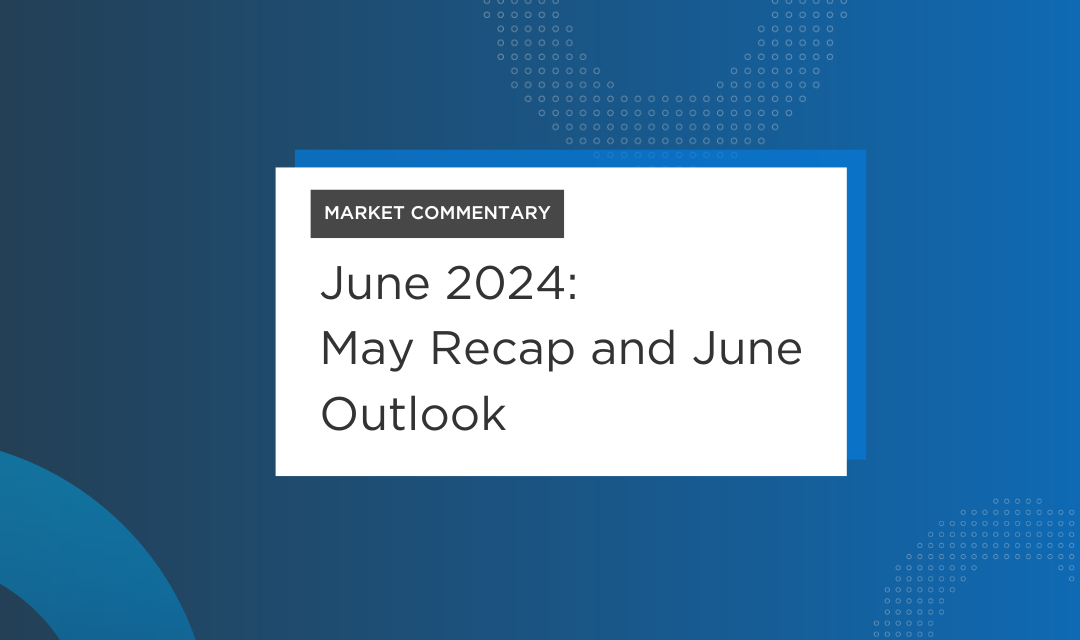May Recap and June Outlook
May was a volatile month for Wall Street. Stocks began May where April ended, with losses. In fact, it wasn’t until the last week of May that stocks posted gains. Throughout the month, investors had to face the prospects of an economic slowdown impacted by accelerating inflation, rising interest rates, the ongoing war in Ukraine, and lukewarm corporate earnings reports. Despite suggestions from Federal Reserve Chair Jerome Powell that the central bank is not likely to raise interest rates by 75 basis points, stubbornly high inflation has set the Fed on a path of quantitative tightening and interest-rate advances that presents a risk to economic growth.
Let’s recap the recent data points as we head into the big one—May inflation—which will be released June 10th:
- The National Association for Business Economics reported a lower projection for GDP. The median forecast for inflation-adjusted gross domestic product (real GDP) for the fourth quarter (Q4) of 2022 is an increase of 1.8% from Q4 2021, compared to a median forecast of 2.9% in the February 2022 survey.
- The survey also addressed respondents’ outlook on recession. More than half (53%) of respondents assign a more than 25% probability of a recession occurring within 12 months.
- The Bureau of Labor Statistics released the May non-farm payrolls on June 3rd. The economy beat expectations and created 390,000 jobs.
- A key manufacturing sector index is still positive. The Institute for Supply Management Purchasing Managers’ Index for May was 56.1. Any number above 50 indicates expansion, while numbers below 50 show shrinkage.
- And consumers are still spending. The Conference Board said on May 31st that its consumer confidence index dipped to 106.4 in May, from 108.6 in April. This is still a strong reading.
What Does All of That Data Add Up To?
The Fed is trying to contain inflation by slowing economic growth. The key inputs are consumer demand for goods, which of course, is driven by strength in consumer balance sheets. And that is driven by full employment and rising wages. The Fed is increasing interest rates, which makes money more expensive.
- Business investment depends on access to capital. Less capital means less growth and fewer jobs.
- Mortgage rates have increased more than 200 basis points. This has already slowed the booming housing market, which will have a knock-on effect on several job sectors.
- Consumer credit is more expensive, which should result in a slowdown in consumer demand.
The Fed is aggressively raising rates at a stated – and unusual — pace of 50 basis points at each of the next several meetings. Even before rates go up, the market begins to price in where rates will be months down the road.
That’s part of what is contributing to the pullback in equities we’ve seen this year. The market is also reacting to uncertainty. There’s no way to know if the Fed will be successful.
Lowering Inflation Requires Slowing Economic Growth – But How Slow Is Too Slow?
The Fed’s stated belief is that the long-term potential growth rate of the U.S. is around 1.8%. Growth at this level would be likely to keep inflation at the Fed’s preferred level of approximately 2%.
How Did the Markets React?
After tickling the bear mid-month, the S&P 500 managed to close in positive territory by a hair of 0.01%. After seven consecutive weeks of declines, the index saw the best weekly performance since November 2020.
All eyes are on inflation. After declining slightly last month, markets will be looking for more evidence that the Fed’s aggressive rate moves are working. Gas prices have bounced back up to levels not seen since the first weeks of the Ukraine invasion. Headline CPI includes energy – so the pressure is on.
It’s probably hard to understate the impact of the inflation number as a market mover. The belief that the Fed would need to be even more aggressive in raising rates – with a potential 75 basis point increase – was in part responsible for the sustained negativity about equity markets. With even a small decrease in inflation,
market sentiment moved back to positive as investors displayed more confidence that rate increases would be at the levels the Fed has outlined.
Equity Markets
- The S&P 500 was up 0.01% in May, bringing its YTD return to -13.30%
- The Dow Jones Industrial Average gained 0.04% for the month and returned -9.21% YTD
- The S&P Mid-Cap 400 increased 0.58% for the month resulting in a -11.51% YTD return
- The S&P Small-Cap 600 declined 1.72% in April, putting the YTD return at -11.85%%
Source: All performance as of May 31st, 2022; quoted from S&P Dow Jones Indices.
The Q1 2022 earnings season is mostly complete, with over 97% of companies reporting. Of 489 issues, 377 beat operating estimates (77.1%), while 350 of the 486 (72.0%) have beaten estimates on sales. The quarter is expected to decline 12.7% from the Q4 2021 record and be up 4.4% over Q1 2021. For 2022, earnings are expected to set another record, increasing 7.5% over 2021.
Bond Markets
The 10-year U.S. Treasury ended the month at 2.85%. Intra month, the key rate reached 3.21%. This marks the first time this rate has been above 3% since December 2018. The Bloomberg U.S. Aggregate Index was up, returning 0.64%. As represented by the Bloomberg Municipal Bond Index, Municipal bonds returned 1.48%. High yield corporate bonds were positive, with the Bloomberg U.S. High Yield Index returning 0.24%.
Powerful Planning Tools: Highlighting Opportunity Zones
Historically tax legislation has offered narrowing parameters when offering investors the ability to reduce or eliminate tax liability, especially when associated with capital gains. Enacted by the Tax Cuts and Jobs Act (TCJA) P.L. 115-97, under I.R.C Sections 1400Z-1 and 1400Z-2 Qualified Opportunity Zones (QOZ) became a rare phenomenon in modern tax legislation. QOZs allows eligible taxpayers to invest eligible gains and receive deferral on realization until December 31st, 2026, along with the elimination of tax on the appreciation of the Qualified Opportunity Fund (QOF) if held for at least ten years. So, who is eligible and how does it work?
Eligible taxpayers entitled to the benefits related to a QOZ are Individuals, C-Corps, S-Corps, Partnerships, Regulated Investment Companies / Real Estate Investment Trust, Trusts, and Estates. Gains are considered to be qualified if they are treated as a capital gain for federal income tax purposes or a qualified Sec. 1231 gain. Potential gains can be deferred from stock, bonds options, business, machinery, buildings, land, livestock, art, wine, and automobiles etc. are all potentially eligible.
The gain is then deferred and included in income on December 31st, 2026. If the investment in the QOF is held for 10 or more years, the investor may elect to increase its basis in the QOF investment to fair market value on the date it’s sold or exchanged. The investor is then not taxed on any capital gain resulting from the appreciation of the investment in the QOF, which is available until December 31st, 2047.
Eye on the Month Ahead
The Federal Open Market Committee meets in June and will almost certainly increase the federal funds target interest rate another 50 basis points, following a similar measure the last time the Committee met in May.
Several economic indicators in April began to show that the economy may be slowing. The May data, available in June, will likely continue this trend.
Before we wrap up, let’s take a look at some bear market statistics:
- According to the Schwab Center for Financial Research, the average bear market lasts only around 15 months.
- A bear market is defined as a drop of 20% from the peak.
- Bear markets are considered to be recession indicators – they begin before a recession starts, as investors become more risk-averse. “Buy the dip” becomes “Shift to cash.”
- They can also simply indicate a temporary lull. That’s what happened in 2020.
The bear was definitely at the door. And he may be back, even if not to stay. The traditional course of action for a bear market is to shift to a defensive strategy and try to cushion your portfolio with more conservative investments that throw off cash. For example, bonds and dividend stocks. However, before you revamp your portfolio – consider your own goals and your plan.
Recession-proofing your entire financial plan means revisiting expenses, reviewing cash planning, understanding your interest charges, and thinking about the long-term. Timing markets isn’t a long-term strategy. It’s too easy to miss when the turn happens, and markets begin to rebound, and being out of the market can be very costly.
One more stat: Ned Davis Research finds that, on average, stocks lose around 36 percent during a bear market. Hartford Funds has the bull market stat: a 114 percent gain on average.
Financial assistance is available! Get matched with a Financial Advisor:
IMPORTANT DISCLOSURES
Part of this material was prepared by Broadridge Investor Communication Solutions, Inc and Seven Group, Inc.
Investment advisory services offered through TCG Advisors, an SEC registered investment advisor. Insurance Services offered through HUB International.
This message is for informational purposes only and does not constitute an offer to sell, a solicitation to buy, or a recommendation for any security, or as an offer to provide advisory or other services in any jurisdiction in which such offer, solicitation, purchase or sale would be unlawful under the securities laws of such jurisdiction. All statements that are not historical facts are forward-looking statements, including any statements that relate to future market conditions, results, strategies, opportunities, positioning or prospects. Economic and market conditions change frequently, there can be no assurance that the trends described here will continue or that any forecasts are accurate. Remember all investing involves risk.
The information contained in this presentation is not intended to be a complete discussion of all federal or state income tax requirements. This information cannot be used by an investor to avoid any income tax penalties that may be imposed under the Internal Revenue Code. Investors should seek advice from a financial and/or tax advisor about the potential tax implications of their investments through TCG Advisors or HUB International, based on their individual circumstances.
Past performance may not be indicative of any future results. No current or prospective client should assume that the future performance of any investment or investment strategy referenced directly or indirectly in this brochure will perform in the same manner in the future. Different types of investments and investment strategies involve varying degrees of risk—all investing involves risk—and may experience positive or negative growth. Nothing in this brochure should be construed as guaranteeing any investment performance.
The information contained in this document is for general guidance only and should not be used as a substitute for your consultation with the appropriate legal, accounting, tax, investment and compensation professionals regarding your personal situation. Before making any decision or taking any action, you should consult a professional about your specific situation. You accept full responsibility for the use of any information in this brochure and in no event will TCG Advisors, or its parents, affiliates, employees or agents, be liable to you or anyone else for any decisions made or action taken in reliance on such information or for any special, consequential, or similar damages, even if advised of the possibility of such damages.


